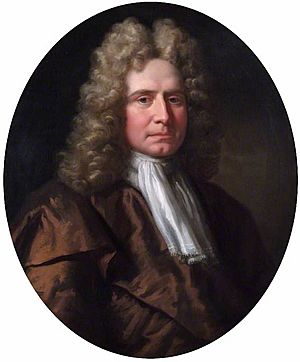Humphry Morice (Governor of the Bank of England) facts for kids

Humphry Morice (born around 1671 – died November 16, 1731) was an important British merchant and politician. He served as a Member of Parliament (MP) and even became the Governor of the Bank of England. He took over his father's trading business when he was about 18 years old. His uncle taught him a lot about money and investing.
Humphry became an MP in 1713. He was part of the Whig political group, which caused some disagreements with his cousin, who was a Tory. Because of this, he needed help from Robert Walpole to get another seat in Parliament in 1722. He rose to become the Deputy Governor and then the Governor of the Bank of England in 1727. He died suddenly in 1731, leaving behind many financial problems.
Contents
Early Life and Business
Humphry Morice was the only son of Humphry Morice (born around 1640 – died 1696). His father was a successful merchant in London. He traded goods in Africa, America, Holland, and Russia. Humphry's mother was Alice, the daughter of Sir Thomas Trollope, 1st Baronet.
Because his mother died early, young Humphry grew up at Werrington. This was the home of his uncle, Sir William Morice, 1st Baronet. Humphry took over his father's business in 1689. His father's will placed him under the care of two other uncles, John and Nicholas. Nicholas was very good at financial trading and taught Humphry these skills.
On June 26, 1704, Humphry married Judith Sandes. She was the daughter of a London merchant. They had three daughters who lived to adulthood: Elizabeth and Judith. Elizabeth later married her stepbrother, Paggen Hale. Judith married George Lee.
Morice's business was very large. In 1707, he was one of four people owed £18,000 by another merchant who went bankrupt. By 1710, he owned over £4,000 of Bank of England stock. This made him eligible to become a director of the Bank. He became a director in 1716 and kept that job. He also helped start the South Sea Company in 1711.
Morice spoke to Parliament several times about trade. In 1707, he talked about losses in the West Indian trade. These losses happened because there were not enough convoys to protect ships. In 1710 and 1713, he argued that the Royal African Company should not have a monopoly (sole control) over trade in West Africa. Because he was so active and wealthy, he wanted to become a Member of Parliament.
The Whydah Gally Ship
In 1715, Humphry Morice ordered the building of a merchant ship called the Whydah Gally. The next year, he chose a Dutch sailor named Lawrence Prince to be its captain. This ship was made to be part of the triangular trade. This trade route connected Europe, Africa, and the Americas.
The Whydah Gally made its first journey in 1716. The next year, while sailing near Cuba and Hispaniola, pirates attacked it. The pirates were led by "Black Sam" Bellamy, who was a famous pirate. Bellamy captured the ship and made it his main ship.
After many attacks on other merchant ships, Bellamy sailed the Whydah Gally to Cape Cod. The ship crashed and sank near Wellfleet on April 26, 1717. The governor of Massachusetts Bay, Samuel Shute, asked a mapmaker named Cyprian Southack to try and get anything valuable from the sunken ship. However, strong storms and local people who did not want to help made it impossible to recover anything important.
Political Career
Humphry's cousin, Sir Nicholas, inherited the Werrington estate in 1690. This estate gave him a lot of influence in elections for the towns of Launceston and Newport. Humphry asked Nicholas to help him get into Parliament in 1710. However, all the seats were already promised. So, Humphry did not become an MP until 1713. He sat with Nicholas for Newport.
Humphry had different political views from his cousin Nicholas. Nicholas was a Tory, but Humphry was a Whig. In 1714, Humphry voted against removing Sir Richard Steele from Parliament. Steele had written a pamphlet supporting the Hanoverian succession, which was about who would become the next king.
Humphry showed up "in a most splendid manner" at court to celebrate the birthday of the new Prince of Wales in late 1714. This made his cousin quite annoyed. Still, Nicholas helped Humphry get re-elected for Newport in the 1715 election.
Their relationship became very difficult in 1716. Humphry had told Nicholas he would oppose the Septennial Act, but then he voted for it. The Septennial Act changed how often elections were held. The next year, Humphry joined Robert Walpole in opposing the government. For a while, both Humphry and Nicholas were against the current leaders.
However, when Walpole returned to the government in 1720, he asked Humphry to help get the London Whigs to vote for important laws. Nicholas lost his patience. He told Humphry to ask Walpole for a seat in Parliament, because he would not help him get re-elected for Newport.
Walpole was willing to help Humphry. He arranged for Morice to be elected for Grampound in 1722, and again in 1727.
Meanwhile, Morice's first wife died in 1720. On June 5, 1722, he married Catherine. She was the daughter of Peter Paggen and the widow of William Hale. They had two sons, Humphry (1723–1785) and Nicholas (died 1748).
Governor and Later Life
Humphry Morice served as Deputy Governor of the Bank of England from 1725 to 1726. He then became Governor of the Bank of England from 1727 to 1729. He died suddenly on November 16, 1731. Some people thought he might have had gout.
After his death, it was discovered that his finances were in great disarray. He had left behind very large debts. The Bank of England tried to get back some of its money from his widow. After many years, they agreed on a settlement of £12,000.
See also
- DNB article at Wikisource

